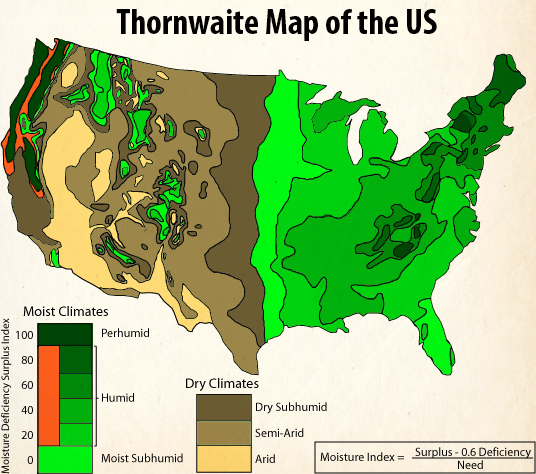Thornthwaite Climate Classification – Geography Notes – For W.B.C.S. Examination.
Thornthwaite climate classification System for describing climates, devised in 1931 and revised in 1948 by the American climatologist C. W. Thornthwaite, that divides climates into groups according to the vegetation characteristic of them, the vegetation being determined by precipitation effectiveness (P/E, where P is the total monthly precipitation, and E is the total monthly evaporation).Continue Reading Thornthwaite Climate Classification – Geography Notes – For W.B.C.S. Examination.
The sum of the monthly P/E values gives the P/E index, which is used to define five humidity provinces, with associated vegetation. A P/E index of more than 127 (wet) indicates rain forest; 64–127 (humid) indicates forest; 32–63 (subhumid) indicates grassland; 16–31 (semi-arid) indicates steppe; less than 16 (arid) indicates desert.
Thornthwaite developed another classification system dependent on the modified potential evapotranspiration (PET) of a region. His concern was with the amount of water available. The driving factor in this system is the water budget of a region. Regions were classified in categories ranging from being humid to arid. The main factor used in classifying climates is then what is most important in the classification. The Thornthwaite system uses temperature as a modifying factor in determining PET, but it is not the major factor as in the Koeppen system. Temperature in this system was a controller of PET, not a direct classification.
In 1948 the system was modified to incorporate a moisture index, which relates the water demand by plants to the available precipitation, by means of an index of potential evapotran-spiration (PE), calculated from measurements of air temperature and day length. In arid regions the moisture index is negative because precipitation is less than the PE. The system also uses an index of thermal efficiency, with accumulated monthly temperatures ranging from 0, giving a frost climate, to more than 127, giving a tropical climate.
Please subscribe here to get all future updates on this post/page/category/website


 Toll Free 1800 572 9282
Toll Free 1800 572 9282  mailus@wbcsmadeeasy.in
mailus@wbcsmadeeasy.in



















































































































